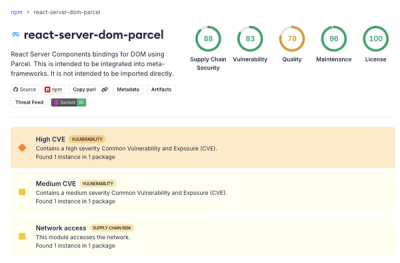
Security News
Deno 2.6 + Socket: Supply Chain Defense In Your CLI
Deno 2.6 introduces deno audit with a new --socket flag that plugs directly into Socket to bring supply chain security checks into the Deno CLI.
pyctuator
Advanced tools
Monitor Python web apps using Spring Boot Admin.
Pyctuator supports Flask, FastAPI, aiohttp and Tornado. Django support is planned as well.
The following video shows a FastAPI web app being monitored and controled using Spring Boot Admin.

The complete example can be found in Advanced example.
Python 3.9+
Pyctuator has zero hard dependencies.
Install Pyctuator using pip: pip3 install pyctuator
Many Java shops use Spring Boot as their main web framework for developing microservices. These organizations often use Spring Actuator together with Spring Boot Admin to monitor their microservices' status, gain access to applications' state and configuration, manipulate log levels, etc.
While Spring Boot is suitable for many use-cases, it is very common for organizations to also have a couple of Python microservices, as Python is often more suitable for some types of applications. The most common examples are Data Science and Machine Learning applications.
Setting up a proper monitoring tool for these microservices is a complex task, and might not be justified for just a few Python microservices in a sea of Java microservices.
This is where Pyctuator comes in. It allows you to easily integrate your Python microservices into your existing Spring Boot Admin deployment.
Pyctuator is a partial Python implementation of the Spring Actuator API .
It currently supports the following Actuator features:
The examples below show a minimal integration of FastAPI, Flask and aiohttp applications with Pyctuator.
After installing Flask/FastAPI/aiohttp and Pyctuator, start by launching a local Spring Boot Admin instance:
docker run --rm -p 8080:8080 --add-host=host.docker.internal:host-gateway michayaak/spring-boot-admin:2.2.3-1
Then go to http://localhost:8080 to get to the web UI.
The following example is complete and should run as is.
from flask import Flask
from pyctuator.pyctuator import Pyctuator
app_name = "Flask App with Pyctuator"
app = Flask(app_name)
@app.route("/")
def hello():
return "Hello World!"
Pyctuator(
app,
app_name,
app_url="http://host.docker.internal:5000",
pyctuator_endpoint_url="http://host.docker.internal:5000/pyctuator",
registration_url="http://localhost:8080/instances"
)
app.run(debug=False, port=5000)
The application will automatically register with Spring Boot Admin upon start up.
Log in to the Spring Boot Admin UI at http://localhost:8080 to interact with the application.
The following example is complete and should run as is.
from fastapi import FastAPI
from uvicorn import Server
from uvicorn.config import Config
from pyctuator.pyctuator import Pyctuator
app_name = "FastAPI App with Pyctuator"
app = FastAPI(title=app_name)
@app.get("/")
def hello():
return "Hello World!"
Pyctuator(
app,
"FastAPI Pyctuator",
app_url="http://host.docker.internal:8000",
pyctuator_endpoint_url="http://host.docker.internal:8000/pyctuator",
registration_url="http://localhost:8080/instances"
)
Server(config=(Config(app=app, loop="asyncio"))).run()
The application will automatically register with Spring Boot Admin upon start up.
Log in to the Spring Boot Admin UI at http://localhost:8080 to interact with the application.
The following example is complete and should run as is.
from aiohttp import web
from pyctuator.pyctuator import Pyctuator
app = web.Application()
routes = web.RouteTableDef()
@routes.get("/")
def hello():
return web.Response(text="Hello World!")
Pyctuator(
app,
"aiohttp Pyctuator",
app_url="http://host.docker.internal:8888",
pyctuator_endpoint_url="http://host.docker.internal:8888/pyctuator",
registration_url="http://localhost:8080/instances"
)
app.add_routes(routes)
web.run_app(app, port=8888)
The application will automatically register with Spring Boot Admin upon start up.
Log in to the Spring Boot Admin UI at http://localhost:8080 to interact with the application.
When registering a service in Spring Boot Admin, note that:
app_url and pyctuator_endpoint_url should use host.docker.internal as the url's host so Spring Boot Admin will be able to connect to the monitored service.pyctuator_endpoint_url must be using the same host and port as app_url.ssl.SSLContext using the ssl_context optional parameter of the Pyctuator constructor.PYCTUATOR_REGISTRATION_NO_CERT environment variable so Pyctuator will disable certificate validation when registering (and deregistering).The following sections are intended for advanced users who want to configure advanced Pyctuator features.
While Pyctuator only needs to know the application's name, we recommend that applications monitored by Spring Boot Admin will show additional build and git details. This becomes handy when scaling out a service to multiple instances by showing the version of each instance. To do so, you can provide additional build and git info using methods of the Pyctuator object:
pyctuator = Pyctuator(...) # arguments removed for brevity
pyctuator.set_build_info(
name="app",
version="1.3.1",
time=datetime.fromisoformat("2019-12-21T10:09:54.876091"),
)
pyctuator.set_git_info(
commit="7d4fef3",
time=datetime.fromisoformat("2019-12-24T14:18:32.123432"),
branch="origin/master",
)
Once you configure build and git info, you should see them in the Details tab of Spring Boot Admin:

In addition to adding build and git info, Pyctuator allows adding arbitrary application details to the "Info" section in SBA.
This is done by initializing the additional_app_info parameter with an arbitrary dictionary.
For example, you can provide links to your application's metrics:
Pyctuator(
app,
"Flask Pyctuator",
app_url=f"http://172.18.0.1:5000",
pyctuator_endpoint_url=f"http://172.18.0.1:5000/pyctuator",
registration_url=f"http://localhost:8080/instances",
app_description="Demonstrate Spring Boot Admin Integration with Flask",
additional_app_info=dict(
serviceLinks=dict(
metrics="http://xyz/service/metrics"
),
podLinks=dict(
metrics=["http://xyz/pod/metrics/memory", "http://xyz/pod/metrics/cpu"]
)
)
)
This will result with the following Info page in SBA:

For services that use SQL database via SQLAlchemy, Pyctuator can easily monitor and expose the connection's health using the DbHealthProvider class as demonstrated below:
engine = create_engine("mysql+pymysql://root:root@localhost:3306")
pyctuator = Pyctuator(...) # arguments removed for brevity
pyctuator.register_health_provider(DbHealthProvider(engine))
Once you configure the health provider, you should see DB health info in the Details tab of Spring Boot Admin:

If your service is using Redis, Pyctuator can monitor the connection to Redis by simply initializing a RedisHealthProvider:
r = redis.Redis()
pyctuator = Pyctuator(...) # arguments removed for brevity
pyctuator.register_health_provider(RedisHealthProvider(r))
Out of the box, Pyctuator exposes Python's environment variables to Spring Boot Admin.
In addition, an application may register an environment provider to provide additional configuration that should be exposed via Spring Boot Admin.
When the environment provider is called it should return a dictionary describing the environment. The returned dictionary is exposed to Spring Boot Admin.
Since Spring Boot Admin doesn't support hierarchical environment (only a flat key/value mapping), the provided environment is flattened as dot-delimited keys.
Pyctuator tries to hide secrets from being exposed to Spring Boot Admin by replacing the values of "suspicious" keys with ***.
Suspicious keys are keys that contain the words "secret", "password" and some forms of "key".
For example, if an application's configuration looks like this:
config = {
"a": "s1",
"b": {
"secret": "ha ha",
"c": 625,
},
"d": {
"e": True,
"f": "hello",
"g": {
"h": 123,
"i": "abcde"
}
}
}
An environment provider can be registered like so:
pyctuator.register_environment_provider("config", lambda: config)
Pyctuator can provide filesystem and memory metrics.
To enable these metrics, install psutil
Note that the psutil dependency is optional and is only required if you want to enable filesystem and memory monitoring.
Pyctuator leverages Python's builtin logging framework and allows controlling log levels at runtime.
Note that in order to control uvicorn's log level, you need to provide a logger object when instantiating it. For example:
myFastAPIServer = Server(
config=Config(
logger=logging.getLogger("uvi"),
app=app,
loop="asyncio"
)
)
Pyctuator supports registration with Spring Boot Admin that requires basic authentications. The credentials are provided when initializing the Pyctuator instance as follows:
# NOTE: Never include secrets in your code !!!
auth = BasicAuth(os.getenv("sba-username"), os.getenv("sba-password"))
Pyctuator(
app,
"Flask Pyctuator",
app_url="http://localhost:5000",
pyctuator_endpoint_url=f"http://localhost:5000/pyctuator",
registration_url=f"http://spring-boot-admin:8080/instances",
registration_auth=auth,
)
Since there are numerous standard approaches to protect an API, Pyctuator doesn't explicitly support any of them. Instead, Pyctuator allows to customize its integration with the web-framework. See the example in fastapi_with_authentication_example_app.py.
The examples folder contains full blown Python projects that are built using Poetry.
To run these examples, you'll need to have Spring Boot Admin running in a local docker container. A Spring Boot Admin Docker image is available here.
Unless the example includes a docker-compose file, you'll need to start Spring Boot Admin using docker directly:
docker run --rm -p 8080:8080 --add-host=host.docker.internal:host-gateway michayaak/spring-boot-admin:2.2.3-1
(the docker image's tag represents the version of Spring Boot Admin, so if you need to use version 2.0.0, use michayaak/spring-boot-admin:2.0.0 instead, note it accepts connections on port 8082).
The examples include
To set up a development environment, make sure you have Python 3.9 or newer installed, and run make bootstrap.
Use make check to run static analysis tools.
Use make test to run tests.
FAQs
A Python implementation of the Spring Actuator API for popular web frameworks
We found that pyctuator demonstrated a healthy version release cadence and project activity because the last version was released less than a year ago. It has 1 open source maintainer collaborating on the project.
Did you know?

Socket for GitHub automatically highlights issues in each pull request and monitors the health of all your open source dependencies. Discover the contents of your packages and block harmful activity before you install or update your dependencies.

Security News
Deno 2.6 introduces deno audit with a new --socket flag that plugs directly into Socket to bring supply chain security checks into the Deno CLI.

Security News
New DoS and source code exposure bugs in React Server Components and Next.js: what’s affected and how to update safely.

Security News
Socket CEO Feross Aboukhadijeh joins Software Engineering Daily to discuss modern software supply chain attacks and rising AI-driven security risks.